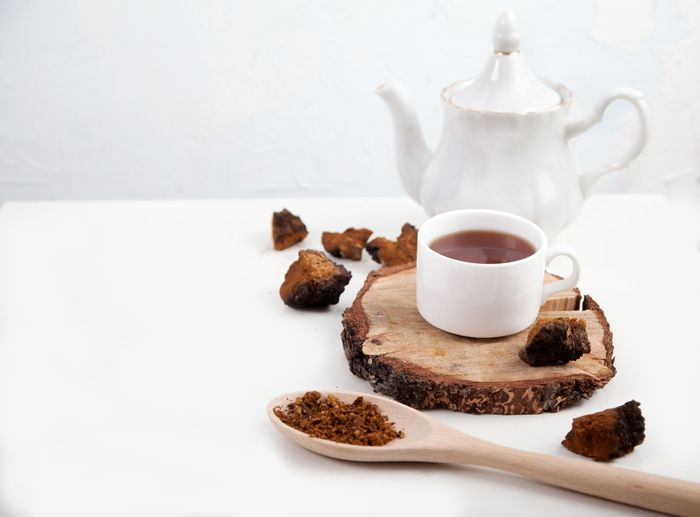Chaga Tea: Benefits, Recipe, and Comparison to Other Chaga Products
Updated April 14, 2023.

Chaga (Inonotus obliquus) is a very thick, fibrous, and woody fungus that grows in cold climates on the bark of trees. Although the part of the Chaga fungus that is harvested and used for its functional benefits isn't technically a mushroom, it is often referred to as such due to the similar benefits it presents.
This article looks at the general benefits and side effects of Chaga, the benefits of Chaga tea over other forms, and offers a recipe for preparing Chaga tea.
Benefits and Side Effects of Chaga Mushrooms
Discussing the total benefits and side effects of Chaga mushrooms would constitute an extensive post, which is why we'll list them very briefly and then link to additional posts that discuss these topics in more detail.
Benefits
- Anti-cancer properties
- Antioxidative properties
- Anti-inflammatory properties
- Immunomodulating properties
- Highly nutritious
For more info, read 6 Chaga Mushroom Benefits.
Side Effects
- Hypoglycemia risk
- May thin blood
- May harm kidneys in rare cases
- Upset stomach
For more info, read Chaga Mushrooms: Risk Factors & 3 Potential Side Effects.
How to Brew Chaga Tea
Chaga tea can be brewed using either whole fungus or ground and powdered Chaga, and the method is largely the same. Follow the steps below to brew yourself a pot of Chaga tea that you can drink now or save for later.
- If you have powdered Chaga, add a few scoops (8-12 teaspoons) to 4-5 cups of boiling water, depending on how concentrated you want it to be. For whole mushrooms (dried or fresh), cut them as thinly as possible and add between 5g (if dried) to 30g (if fresh) to 4-5 cups of boiling water.
- Let the mushrooms simmer for about 2 hours.
- Add flavourings in the last 5 minutes as needed, such as (ginger, honey, or chamomile).
- Strain Chaga pieces out (if using dried or fresh mushrooms) and store them away for later use. They can be used 2 or 3 times in this manner.
- Serve Chaga tea hot or cold.
Aside from brewing a pot of Chaga tea that serves 3-5 people, you can also add 2-3 teaspoons of powdered Chaga to any hot beverage as it should dissolve.
Chaga Tea Benefits vs Other Methods
Consuming Chaga in the form of tea is one of many different methods, each of which has its own advantages and disadvantages compared to other forms. The benefits and drawbacks of Chaga tea compared to other methods are discussed below:
Advantages
- Easy to add other components Brewing a pot of Chaga tea allows you to also add a variety of other therapeutic and tasty substances to improve the functional and personal experience. For example, you can brew Chaga tea in conjunction with chamomile to utilise the benefits of chamomile tea as well as Chaga.
- Habit-forming When trying to construct new habits or incorporate new beneficial compounds into your life, one of the factors that people struggle with most is consistency, and consistency is crucial for functional mushroom use. However, most people already have a warm beverage routine of some kind, which can be tweaked slightly to make it significantly easier to get your daily dose of Chaga.
- Heat breaks down chitin Many of the beneficial nutrients found in functional mushrooms can't be accessed by our bodies unless the external layer of chitin is first broken down, either by chemicals or heat. Chaga's texture and taste make it unsuitable for cooking, so steeping it in boiling water can still break down the chitin if you don't have access to tinctures or other similar products.
- Reusable Since not all of the nutrients are drawn out of the Chaga mushrooms from a single boil, you can reuse pieces of Chaga 2 or 3 times before they need to be discarded.
Disadvantages
- Time-consuming Since brewing a pot of Chaga tea can take a few hours, it is a far more tedious process than simply taking a few drops of Chaga tincture.
- Difficult to control the dosage Since not all of the nutrients are drawn out from a single boil and many factors can influence the rate at which they are, it is far more difficult to control the Chaga dosage in tea than it is in tinctures or capsules.
- Some nutrients are water-insoluble Not all of the nutrients can be extracted with water, meaning that Chaga tea is less bioavailable than other methods like tinctures.
Best Way to Consume Chaga Mushrooms
Even though there are many benefits of Chaga tea over other methods, does this mean that Chaga tea is the best way of consuming Chaga mushrooms? Not necessarily.
In fact, the best combination of bioavailability and ease of use when it comes to different types of functional mushroom products is tinctures applied sublingually. However, it also needs to be stated that some of the nutrients found in Chaga can only be absorbed across the intestinal wall, which means that if you want to get the most out of this amazing fungus, a good mix of sublingual application and ingestion is your best bet.







